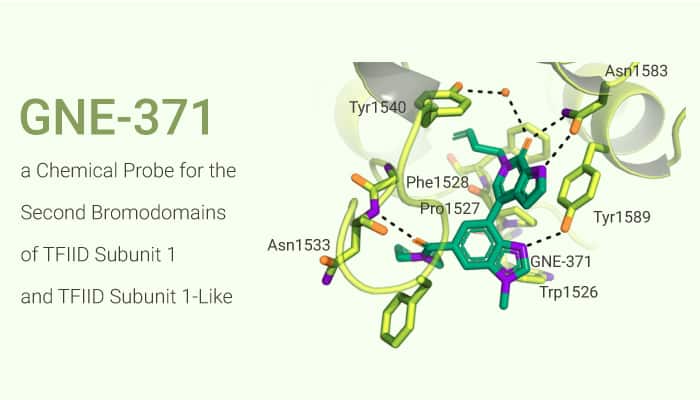Bromodomains are protein modules that serve as epigenetic readers. These modules consist of 110 amino acids, specifically recognize acetylated lysine residues on histone tails. They also play important roles in chromatin-structural changes and transcriptional regulation.
A number of inhibitors of the bromodomain and extra terminal (BET) family and non-BET bromodomains have been disclosed recently. However, researchers have not identified a highly selective inhibitor of the second bromodomain of the human transcription-initiation-factor TFIID subunit 1 (TAF1(2)).
TAF1 contains a histone acetyltransferase (HAT) domain and a tandem bromodomain module. This tandem bromodomain module contains the individual bromodomains TAF1(1) and TAF1. A TAF1(2)-bromodomain inhibitor would be a valuable tool compound for investigations into the pharmacological relevance of non-BET bromodomain proteins.
In this article. We will introduce an in vitro probe of the TAF1(2) bromodomain, GNE-371.

GNE-371 binds TAF1(2) with an IC50 of 10 nM while maintaining excellent selectivity over other bromodomain-family members. Additionally, GNE-371 is also active in a cellular-TAF1(2) target-engagement assay (IC50=38 nM) and exhibits anti-proliferative synergy with the BET inhibitor JQ1. The above result suggests the engagement of endogenous TAF1 by GNE-371 and further supporting the use of GNE-371 in mechanistic and target-validation studies.
In a BROMOscan panel against 40 bromodomain-family members. GNE-371 exhibits exquisite selectivity, with only BRD4 (full length protein, KD=8900 nM), CECR2 (KD=1200 nM), and BRD9 (KD=3400 nM) potencies below 10 μM. Whereas the potencies for TAF1(2) and its homolog TAF1L(2) are very strong, exhibiting kD values of 1 and 5 nM, respectively.
In nanoBRET assay, cells transfected with nLuc−TAF1 with a fluorescent-tagged ligand resulted in a BRET signal. In this assay, BET inhibitor JQ1 demonstrates a potency of 0.3 μM, Meanwhile, GNE-371 can not displace tracer even at the highest test concentration (20 μM), indicating a cellular selectivity of >500-fold for TAF1(2) over BRD4.
Summary, GNE-371 is a potent chemical probe for the second bromodomains of TFIID subunit 1 and TFIID subunit 1-like.
Reference:
Wang S, et al. J Med Chem. 2018 Oct 25;61(20):9301-9315.